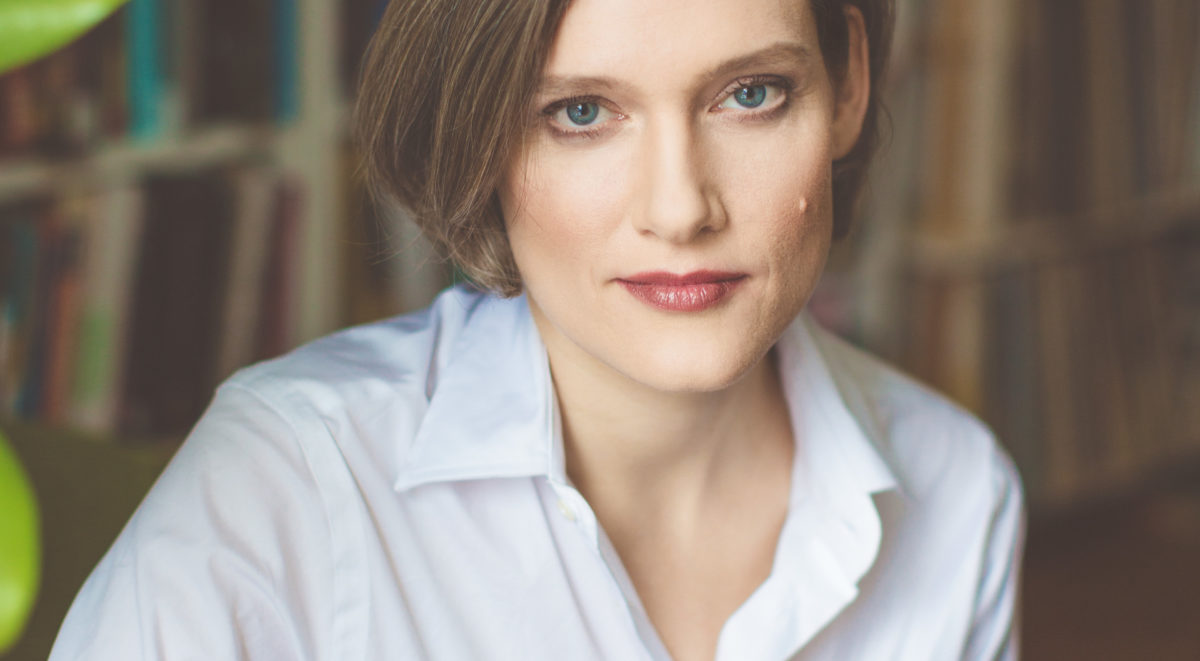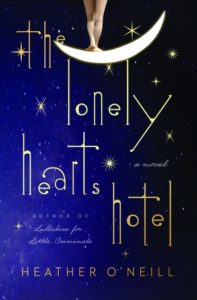
Interview by Anjalika Samarasekera
Heather O’Neill is the bestselling, Giller Prize-shortlisted author of Lullabies for Little Criminals, The Girl Who Was Saturday Night, and Daydreams of Angels. Her fourth work of fiction, The Lonely Hearts Hotel, is forthcoming from HarperCollins Canada in February 2017. I spoke with Heather over email about her new book, Montreal, and the three “r’s” of writing: rejection, risk-taking, and the art of being ribald:
I love the story of how you got Lullabies for Little Criminals published. In particular, the early rejection notes you received that the novel was “unpublishable” and should be “thrown in the trash.” Looking back, what kept you working on the book? Did you ever doubt yourself?
I think I knew it was supposed to be a struggle. And I was really young and had a “get rich or die trying” attitude that made me resilient and confident. I thought I could be a great writer. I woke up in the morning and it never occurred to me that I was any different than George Eliot.
I love those years because they were so bohemian: living in a cheap apartment, working on a manuscript. I snuck into an office at my friend’s work to print off the manuscript because I couldn’t afford to do it on my own. My seven-year-old daughter wrote the page numbers on the corners of the pages and the numbers were all messed up because she would lose count. I carried the manuscript in a plastic grocery bag on the subway and I went to interviews in a pin-striped suit I got at the Women’s Centre free box.
Now, of course, the struggle seems charming and humorous as it perhaps wasn’t at the time (do you like how I’m telling this story as though I’m eighty). At least I didn’t cut off an ear and give it to a handsome busboy.
Lullabies was a huge success for reasons that seem so obvious now. One being that the book is risky in terms of content and voice. Do you consciously take risks in your writing? What does that look like for you?
I think I’ve always taken risks in my life. I was always interested in subversion, in taboo sexual subject matter, in anything transgressive, in anything bold. I remember reading all the perverts. I was that kind of young person. I liked anything that defied convention because it was a way of becoming free, of thinking for one’s self. I was interested in the erotic experience and being in a female body. There was a feeling of being a criminal and outsider just by being a free spirited, free thinking girl.
There are these thoughts we have in our head that always seem taboo and we don’t share them. Those are wonderful reservoirs to draw on for art. To speak the unspeakable. To be honest about the things that I think and obsess about and not wonder what’s permissible or considered beautiful by others.
To me your female characters are fragile yet unbreakable and I think it has something to do with the way you use humour to empower these women in telling their stories.
It’s subversive to be funny as a woman because you’re demanding that something is more important than your looks. I’ve loved funny girls my whole life. All the women I’ve been close to have been really funny. When women are being funny they are doing it to be heard, to be irreverent, to be bold. Humour is intelligence when it’s drunk, letting loose, after work, self-destructive and daring.
When did you first realize you could make a funny story out of really sad stuff?
Humour relies on sadness. My characters are funny because they take themselves seriously when they are losers. I describe them that way because it comes from something that always broke my heart as a child. Human dignity is so funny. It’s so wonderful and sweet.
Your books are rooted in a Montreal you know well and I’m reminded of the relationship between Alice Munro and Huron County. Do you feel that Montreal is an inexhaustible source of material for you?
Montreal is filled with marvelous details. I could write a hundred novels from any block. All the strange details people add: a little Virgin Mary on a windowsill, a sad poodle in a fenced front yard. It’s a very makeshift city. My neighbourhood looks like it was built by an eighty-nine year old woman with a pile of broom handles, wire coat hangers, pickle jars, a hammer and a pot with a rose bush in it. It takes a certain mentality to live in Montreal. You have to not mind the street caving in at any moment.
 Your new novel, The Lonely Hearts Hotel, centers around an orphanage in the neighbourhood you grew up in. Does the orphanage actually exist? Why does this appeal to you as a subject for a novel?
Your new novel, The Lonely Hearts Hotel, centers around an orphanage in the neighbourhood you grew up in. Does the orphanage actually exist? Why does this appeal to you as a subject for a novel?
On the first page (of The Lonely Hearts Hotel) there is a line-up of girls at the Hôpital de la Miséricorde. It was an institution that accepted single pregnant women and kept them almost as prisoners. Your freedom is such a precarious thing as a woman. It was even more so back then, obviously. The minute you slept with a man, your body wasn’t your own. You were no longer free. The consequences for sex are so different for women. I was interested in the shaming of young pregnant women, which is probably related to my having been a young single mother myself and how difficult that was.
The characters are all orphans who are starting from scratch without any inherited history. I liked the idea of using that to their advantage.
Do the books you’ve written surprise you or are they what you expected to write? Can you trace the origins of your voice and style?
My father was always telling me bedtime stories of crimes that he and his friends committed when they were very young. That had a big influence on my voice and storytelling. Later on, while at McGill (University) I started delving into the works of so many writers that informed my style: Anaïs Nin, Henry Miller, Jean Cocteau, Jean Genet, Antonin Artaud, Simone de Beauvoir, Violette LeDuc, Georges Bataille, Marguerite Duras. Basically anyone who’d slept around in Paris. Film was a big influence too. I remember sitting in the repertory cinema watching Nouvelle Vague films about philosophizing criminals, the gentleman gangster, the melancholic prostitute. There was something I wanted to capture of the sweetness of the heroine of black and white movies, the way girls were photographed in the 1930s, pornographic postcards, girls backstage at a big theatre in New York leaning in close to put their makeup on, and girls in a factory line. There’s been an attempt to make all girls identical since the beginning of the 20th century. I wanted to find a radicalized girl in all of that. I was curious what kind of personality one of these girls would have if she went intellectually rogue.
Final question, is there any particular activity you do that you feel is indispensable to your work? For example, some writers are fanatic about hiking or running. Others play an instrument or paint. What feeds your work?
I’m really into fashion. I was a clothes horse since I was a young teenager. I was always going to thrift stores and outlets and putting together elaborate outfits, trying to look like a Henry James character, male or female, I didn’t care. So I’d always have a pink suit, peeling leather high-heel boots and a crushed top hat.
I never thought I’d love being in my forties as much as I do. I much prefer the way I look now than I did in my twenties. When I buy clothes I like to harken back to female intelligentsia of the past, especially Collette in her sixties, Jean Rhys in her seventies, Simone de Beauvoir in her forties. I want to look deadly smart.
But no, other than getting myself dressed in the morning and eating, I don’t do anything. I take my bicycle to McGill library, take out piles of books, go home and read them.
Anjalika Samarasekera is a Vancouver writer and former criminal lawyer. She is currently pursuing her MFA through the Optional Residency Program at UBC.